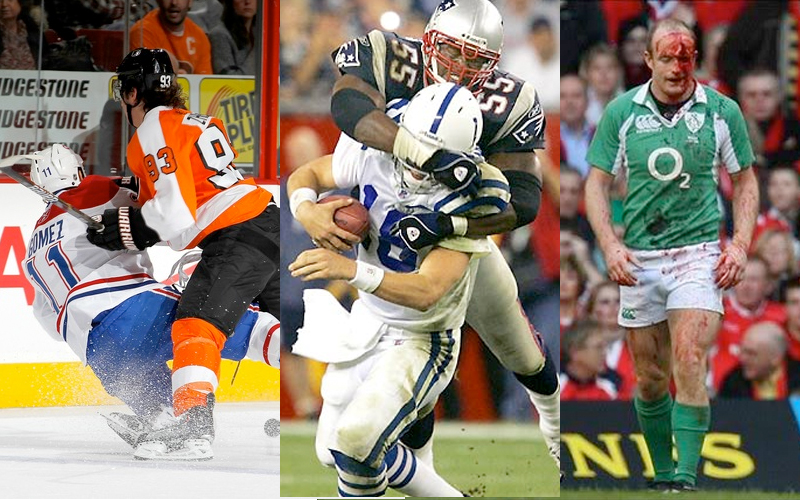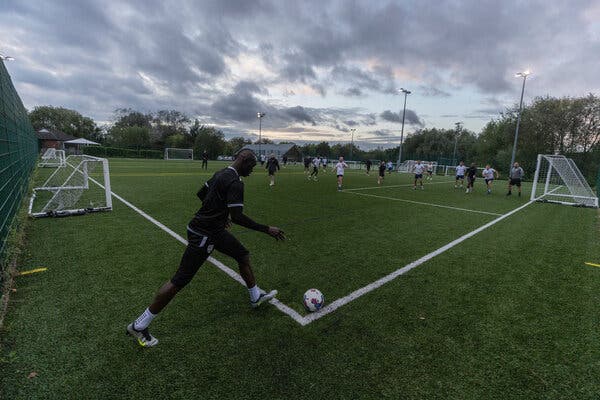As an Amazon Associate, I earn from qualifying purchases.
Football and hockey are widely popular sports with inherent physical risks. Both games can lead to injuries, making them potentially dangerous.
Sporting activities like football and hockey bring together fans and athletes around the world for thrilling competition and display of skill. While football, with its global appeal, dominates as the world’s most beloved sport, hockey holds a special place in colder climates and has a dedicated following.
Both sports require agility, endurance, and strategic gameplay, but they also come with their set of risks. Contact in football, ranging from tackles to headers, can cause concussions and other injuries. Similarly, hockey’s high-speed skating, body checks, and flying pucks add elements of danger. Players must consistently adhere to safety protocols to minimize these dangers. Nevertheless, the widespread passion for these sports continues to grow, as does the commitment to making them safer for everyone involved.
Credit: www.businessinsider.com
Injury Trends
Sports like football and hockey are fast, exciting, and full of action. Yet, with high impacts come high risks. Players often face injuries both minor and severe. Here, we discuss the most common injuries in these sports. We examine how often they happen and compare injury rates between football and hockey.
Prevalence Of Injuries In High Impact Sports
Injury rates in sports like football and hockey are higher than in non-contact sports. Collisions, falls, and fast movements make players more prone to getting hurt. Issues like concussions, sprains, and fractures are common in these games. Not just professionals but even young athletes face such risks. Schools and clubs teach safe play to prevent injuries.
- Concussions
- Knee ligament tears
- Broken bones
- Shoulder dislocations
- Ankle sprains
Comparison Of Football And Hockey Injury Rates
Football and hockey both have high injury rates. Let’s compare them to understand the risks better.
| Sport | Common Injuries | Incidence Rate |
|---|---|---|
| Football | Concussions, Knee Injuries | High |
| Hockey | Concussions, Shoulder Injuries | Moderately High |
In football, concussions are a serious concern. Players can clash heads or hit the ground hard. Hockey players wear more protective gear but still get concussions. They can hit the boards or get struck by pucks. Knee injuries are more common in football. In hockey, shoulder injuries from checks are frequent.
Preventing injuries is key. Both sports have safety rules and equipment. Practices like warm-ups and proper technique help too. Teams need good doctors and physios. They help injured players heal and get back to playing safely.
Understanding these injury trends is vital. It helps players, coaches, and fans recognize the risks. It also guides improvements in safety gear and rules. Being aware can keep high-impact sports safer for everyone.

Credit: www.amenclinics.com
Head Trauma
Head injuries in sports like football and hockey are serious concerns. The impact of repeated collisions puts players at risk for head trauma. Recognizing and managing concussions is vital for player safety. This post takes a closer look at the long-term effects of head injuries and examines concussion protocols in both sports.
Long-term Effects Of Head Trauma
Repeated head injuries can lead to lasting brain damage. Symptoms might not show up for years.
- Memory Loss: Players may have trouble remembering things.
- Depression: Mood changes are common, leading to sadness or anger.
- Chronic Traumatic Encephalopathy (CTE): A severe, progressive brain condition.
Concussion Protocols In Football And Hockey
Sports organizations have implemented strict guidelines to protect athletes from serious injuries. Let’s dive into protocols designed to keep players safe in football and hockey.
| Sport | Concussion Protocol Highlights |
|---|---|
| Football |
|
| Hockey |
|
Physical Demands
The intensity of sports like football and hockey can’t be understated. Athletes push their limits to excel. This segment unveils what it takes to meet the physical demands of these sports and the risks of not preparing adequately.
Fitness Requirements For Football And Hockey
Both football and hockey demand remarkable stamina, speed, and strength. Players must possess the endurance to last a full match or game, which often extends beyond 90 minutes or three periods, respectively. Training regimens focus on building these physical attributes:
- Cardiovascular fitness: To sustain high energy levels
- Muscular strength: For powerful movements and tackles
- Agility: To maneuver swiftly across the field or rink
Structured workouts include sprinting drills, weight lifting, and agility exercises. Teams often implement tactical plays that hinge on a player’s physical prowess.
Consequences Of Overtraining And Inadequate Conditioning
Ignoring the fitness requirements can lead to serious injuries and burnout. Overtraining is just as risky as poor conditioning. The consequences are significant:
| Issue | Overtraining | Inadequate Conditioning |
|---|---|---|
| Physical | Chronic fatigue, injuries | Lower performance, higher injury risk |
| Mental | Stress, burnout | Lack of confidence, mental blocks |
Balance in training is crucial. Players require adequate recovery time between intense workouts. Coaches must ensure players build their physical condition progressively.
Risk Factors
Sports like football and hockey are thrilling. But they can be dangerous too. Knowing about risk factors helps us stay safe. Let’s dive into two important areas: genetics, body type, and the role of gear.
Genetics And Body Type
Some people are born with traits that may increase injury risks. Their body type and genetics play a role. Sports need different body strengths. Some bodies handle hits better than others. This doesn’t mean certain people can’t play sports. But they should know their unique risks. Training and conditioning can help.
- Joint flexibility can affect how one handles falls or hits.
- Muscle strength provides protection to bones and joints.
- Bone density matters when it comes to fractures or breaks.
Role Of Protective Gear
Protective gear is a game-changer. It reduces risks of getting hurt. From helmets to pads, every piece has a job. Gear must fit right and be sport-specific. Players should wear them always—during practice and in games. Gear checks are a must. Look for wear and tear. Replace old gear on time.
| Sport | Essential Gear |
|---|---|
| Football | Helmet, Shoulder Pads, Mouthguard |
| Hockey | Helmet, Shin Guards, Gloves |
Prevention Strategies
Playing sports like football and hockey is not without risk. Understanding prevention strategies is key to reducing the chance of injury. Coaches, trainers, and players must work together to promote a safe environment. Let’s dive into the crucial steps we can take to keep the game fun and athletes out of harm’s way.
Importance Of Proper Technique
Learning proper technique is essential in any sport. It protects athletes from injuries. Coaches should prioritize teaching these techniques from the start. This includes how to tackle in football and stick handling in hockey. Frequent drills reinforce muscle memory and help players react safely under pressure.
Avoiding Dangerous Situations On The Field Or Rink
- Stay aware of surroundings to anticipate and avoid collisions.
- Adhere to rules designed to minimize risks, such as no high-sticking in hockey.
- Ensure adequate rest to prevent fatigue-related errors.
Safety Guidelines For Coaches And Trainers
| Area | Guidelines |
|---|---|
| Equipment Checks | Verify protective gear fits correctly and is in good condition. |
| Emergency Plans | Have clear procedures for dealing with injuries, including first aid. |
| Training Limits | Set reasonable practice durations and intensity to prevent burnout. |

Credit: bleacherreport.com
Frequently Asked Questions For Football,hockey,dangerous
Is Ice Hockey As Dangerous As Football?
Both ice hockey and football carry the risk of injury, but football tends to have a higher incidence of serious injuries. Despite protective gear in hockey, it shares football’s risks due to high speeds and physical contact.
Which Has More Concussions Football Or Hockey?
Football reports more concussions than hockey. Studies indicate a higher incidence rate in football due to frequent high-impact collisions.
Is Hockey Tougher Than Football?
Determining if hockey is tougher than football isn’t straightforward because both sports require different skill sets and have unique physical demands. Player opinions and sport-specific challenges vary, making a direct comparison subjective.
What Sport Has The Most Injuries In High School?
American football experiences the highest number of injuries among high school sports.
Conclusion
Exploring the thrill of football and hockey reveals a blend of exhilaration and risk. Both sports captivate fans with dynamic plays and fierce competition. While safety measures are evolving, athletes and enthusiasts alike should always prioritize well-being. Embrace the passion, but never sideline safety’s importance.
Enjoy the game responsibly.
Amazon and the Amazon logo are trademarks of Amazon.com, Inc, or its affiliates.

